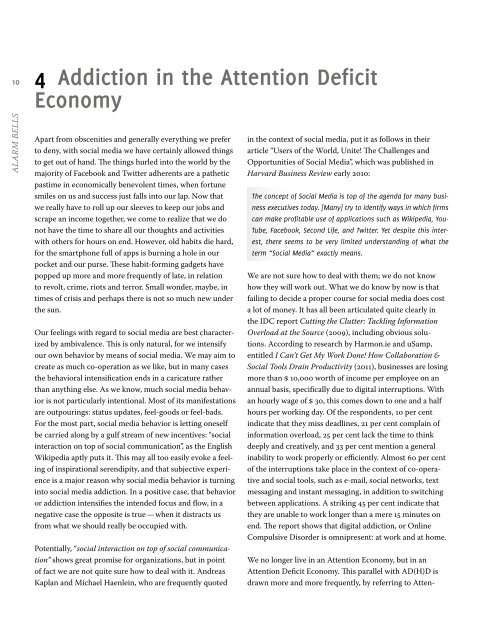VINT-The-Dark-Side-of-Social-Media-Alarm-Bells-Analysis-and-the-Way-Out
VINT-The-Dark-Side-of-Social-Media-Alarm-Bells-Analysis-and-the-Way-Out
VINT-The-Dark-Side-of-Social-Media-Alarm-Bells-Analysis-and-the-Way-Out
Create successful ePaper yourself
Turn your PDF publications into a flip-book with our unique Google optimized e-Paper software.
10<br />
alarM BellS<br />
4 Addiction in <strong>the</strong> Attention Deficit<br />
Economy<br />
Apart from obscenities <strong>and</strong> generally everything we prefer<br />
to deny, with social media we have certainly allowed things<br />
to get out <strong>of</strong> h<strong>and</strong>. <strong>The</strong> things hurled into <strong>the</strong> world by <strong>the</strong><br />
majority <strong>of</strong> Facebook <strong>and</strong> Twitter adherents are a pa<strong>the</strong>tic<br />
pastime in economically benevolent times, when fortune<br />
smiles on us <strong>and</strong> success just falls into our lap. Now that<br />
we really have to roll up our sleeves to keep our jobs <strong>and</strong><br />
scrape an income toge<strong>the</strong>r, we come to realize that we do<br />
not have <strong>the</strong> time to share all our thoughts <strong>and</strong> activities<br />
with o<strong>the</strong>rs for hours on end. However, old habits die hard,<br />
for <strong>the</strong> smartphone full <strong>of</strong> apps is burning a hole in our<br />
pocket <strong>and</strong> our purse. <strong>The</strong>se habit-forming gadgets have<br />
popped up more <strong>and</strong> more frequently <strong>of</strong> late, in relation<br />
to revolt, crime, riots <strong>and</strong> terror. Small wonder, maybe, in<br />
times <strong>of</strong> crisis <strong>and</strong> perhaps <strong>the</strong>re is not so much new under<br />
<strong>the</strong> sun.<br />
Our feelings with regard to social media are best characterized<br />
by ambivalence. This is only natural, for we intensify<br />
our own behavior by means <strong>of</strong> social media. We may aim to<br />
create as much co-operation as we like, but in many cases<br />
<strong>the</strong> behavioral intensification ends in a caricature ra<strong>the</strong>r<br />
than anything else. As we know, much social media behavior<br />
is not particularly intentional. Most <strong>of</strong> its manifestations<br />
are outpourings: status updates, feel-goods or feel-bads.<br />
For <strong>the</strong> most part, social media behavior is letting oneself<br />
be carried along by a gulf stream <strong>of</strong> new incentives: “social<br />
interaction on top <strong>of</strong> social communication”, as <strong>the</strong> English<br />
Wikipedia aptly puts it. This may all too easily evoke a feeling<br />
<strong>of</strong> inspirational serendipity, <strong>and</strong> that subjective experience<br />
is a major reason why social media behavior is turning<br />
into social media addiction. In a positive case, that behavior<br />
or addiction intensifies <strong>the</strong> intended focus <strong>and</strong> flow, in a<br />
negative case <strong>the</strong> opposite is true — when it distracts us<br />
from what we should really be occupied with.<br />
Potentially, “social interaction on top <strong>of</strong> social communication”<br />
shows great promise for organizations, but in point<br />
<strong>of</strong> fact we are not quite sure how to deal with it. Andreas<br />
Kaplan <strong>and</strong> Michael Haenlein, who are frequently quoted<br />
in <strong>the</strong> context <strong>of</strong> social media, put it as follows in <strong>the</strong>ir<br />
article “Users <strong>of</strong> <strong>the</strong> World, Unite! <strong>The</strong> Challenges <strong>and</strong><br />
Opportunities <strong>of</strong> <strong>Social</strong> <strong>Media</strong>”, which was published in<br />
Harvard Business Review early 2010:<br />
<strong>The</strong> concept <strong>of</strong> <strong>Social</strong> <strong>Media</strong> is top <strong>of</strong> <strong>the</strong> agenda for many business<br />
executives today. [Many] try to identify ways in which firms<br />
can make pr<strong>of</strong>itable use <strong>of</strong> applications such as Wikipedia, You-<br />
Tube, Facebook, Second Life, <strong>and</strong> Twitter. Yet despite this interest,<br />
<strong>the</strong>re seems to be very limited underst<strong>and</strong>ing <strong>of</strong> what <strong>the</strong><br />
term “<strong>Social</strong> <strong>Media</strong>” exactly means.<br />
We are not sure how to deal with <strong>the</strong>m; we do not know<br />
how <strong>the</strong>y will work out. What we do know by now is that<br />
failing to decide a proper course for social media does cost<br />
a lot <strong>of</strong> money. It has all been articulated quite clearly in<br />
<strong>the</strong> IDC report Cutting <strong>the</strong> Clutter: Tackling Information<br />
Overload at <strong>the</strong> Source (2009), including obvious solutions.<br />
According to research by Harmon.ie <strong>and</strong> uSamp,<br />
entitled I Can’t Get My Work Done! How Collaboration &<br />
<strong>Social</strong> Tools Drain Productivity (2011), businesses are losing<br />
more than $ 10,000 worth <strong>of</strong> income per employee on an<br />
annual basis, specifically due to digital interruptions. With<br />
an hourly wage <strong>of</strong> $ 30, this comes down to one <strong>and</strong> a half<br />
hours per working day. Of <strong>the</strong> respondents, 10 per cent<br />
indicate that <strong>the</strong>y miss deadlines, 21 per cent complain <strong>of</strong><br />
information overload, 25 per cent lack <strong>the</strong> time to think<br />
deeply <strong>and</strong> creatively, <strong>and</strong> 33 per cent mention a general<br />
inability to work properly or efficiently. Almost 60 per cent<br />
<strong>of</strong> <strong>the</strong> interruptions take place in <strong>the</strong> context <strong>of</strong> co-operative<br />
<strong>and</strong> social tools, such as e-mail, social networks, text<br />
messaging <strong>and</strong> instant messaging, in addition to switching<br />
between applications. A striking 45 per cent indicate that<br />
<strong>the</strong>y are unable to work longer than a mere 15 minutes on<br />
end. <strong>The</strong> report shows that digital addiction, or Online<br />
Compulsive Disorder is omnipresent: at work <strong>and</strong> at home.<br />
We no longer live in an Attention Economy, but in an<br />
Attention Deficit Economy. This parallel with AD(H)D is<br />
drawn more <strong>and</strong> more frequently, by referring to Atten-


